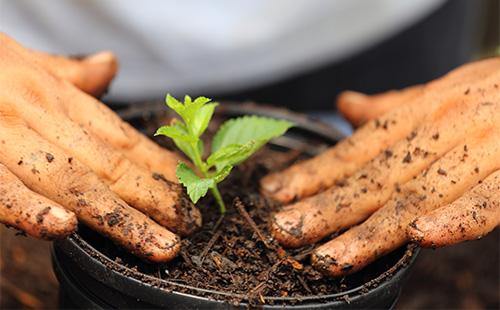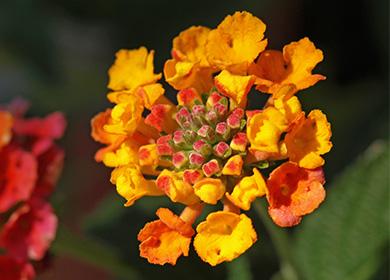The content of the article
Lantana in nature is a wide and sprawling shrub with spherical inflorescences. And the hybrid varieties of this flowering "chameleon", grown specifically for home floriculture, on the contrary, are very compact and miniature. Initially, this shrub grew exclusively in Mexico and India. However, today it has taken root both in the Central Asian countries and on the Mediterranean coast. More and more often we find lantana in summer cottages and in city front gardens. Not to mention the window sills that Lantana has chosen, it seems, seriously and for a long time.
"Home" varieties
There are several dozen species of this plant. But not all are suitable for growing in a pot. Some do not fit in a tub at all - they are so spreading and magnificent.
Lantana camara is considered the most popular species of this oriental shrub. In some sources it is called prickly, in others - vaulted. This is a plant with oval, heart-shaped leaves. Gradually, the yellow inflorescences of the camara lantana are fantastically colored in red, and pink in orange. Magic, and only.
Growing lanthanum at home does not require special skills. And, perhaps, after the first experiment, you will want to “make friends” with other varieties of chameleon plants. The table shows the most attractive species in demand in the flower growing environment.
Table - Varieties of domesticated lanthanum
| Grade name | Color inflorescences | Features |
|---|---|---|
| Pink queen | - hot pink | - The buds have a salmon yellow gradient |
| The Snow Queen | - snow-white | - Clear fluffy, spherical inflorescences |
| Cloud of gold | - yellow | - Has a very rich, intense color |
| Spreading sunset | - Varied: palette from yellow to pale pink | - Creeping ground variety |
| Lantana Montevidea | - Varied: from white to deep purple | - Perennial shrub that spreads on the ground |
Lanthanum Care Rules
Once in the garden center and finding lantana on its multi-colored shelves, do not rush to go to the cashier and pay for a fragrant purchase. First, carefully inspect the stem and leaves of the plant - are there any pests. Reviews of flower growers indicate that shop lanthanum often gets into houses already affected whitefly - dangerous to representatives of the flora insects.
After buying, lanthanum care begins with the installation of the pot in a well-lit and well-protected place from drafts. Ideally, a chameleon plant should be placed on a window with dull cusps that never opens. Another thing is if the yard is summer. In the hot season, lantana feels great in the garden, on the veranda or front garden. And the “urban” shrubs can decorate a balcony or window space with their blooming appearance.
Lighting
Lantana is not one of those who fear direct sunlight. Therefore, it’s difficult to miss the organization of lighting suitable for her. Settle the plant where there is a lot of sunlight, and do not worry about the fact that excess ultraviolet light will negatively affect the health of the flower.
Temperature
Lantana was born in a tropical climate, so even hybrid varieties are warmly vital. The optimum temperature for growth and flowering is 22-27 ° C. But the heat is stronger, which usually happens in our latitudes in the summer, the plant tolerates persistently. If it is unbearably stuffy in the house or on the street, it is enough to simply strengthen the watering of the flower.
Humidity
The plant does not require high humidity. Around him you do not have to run day and night with a spray gun. Spraying should be done no more than once every two to three weeks, trying not to direct the stream at the inflorescences.

Watering
The most important thing about caring for lanthanum is regular watering. In the summer, the plant is often thirsty. As soon as you notice that the topsoil is completely dry, hurry to water the "eastern beauty." And not with tap water, but at least a couple of days with a settled liquid. Ideally, lanthanum should be watered with either filtered water or mineral water - only without gas.
Top dressing
Connoisseurs advise: during the flowering period, it is better to feed the tropical princess. For this purpose, it is worth buying a liquid mineral fertilizer in a flower shop. A universal fertilizer for flowering ornamental plants is perfect.
Conditions in the cold
Lanthanums, planted in open ground, with the onset of frost should migrate into pots and tubs and settle at home. Shrubs should not be kept above the battery. The optimum temperature for lanthanum at this time of the year is from 10 ° C to 12 ° C. She, like most of her green counterparts, “falls asleep” in winter and does not require intensive moisturizing. Watering lanthanum during this period is necessary only purely symbolically, little by little - once every three to four weeks. It is best taken out a tub with a plant on a balcony or in another poorly heated room of a house or apartment. Knowing how to care for lanthanum in winter, a caring florist will help his "eastern beauty" easily survive the cold and gain strength for flowering next summer.
Breeding methods
There are two ways to achieve “offspring” from a lushly flowering plant. The first of them is cuttings in the winter season, and the second is reproduction using seeds. It is impossible to propagate this tropical flower with a leaf.
Option number 1
Features This method is used from early February to mid-March. It is relevant for a healthy, successfully survived winter shrub.
Action algorithm
- Cut the upper parts of the branches of lanthanum eight to ten centimeters.
- Cooking pots with a substrate.
- Moisturize it well.
- We root the lantana in the form of a stalk.
- We maintain the temperature around the pot within 20-22 ° C.
- After three weeks, we rearrange the pots in a cool place with a temperature of about 12 ° C.
- We constantly pinch small lanthanums to get miniature spherical home-grown shrubs.

Option number 2
Features In nature, lanthanum is propagated by seed. They can be purchased at the flower shop.Planting seeds can begin right after the celebration of the New Year. The deadline is mid-March.
Action algorithm
- We fill the pots with a fluffy substrate.
- We sow lantana.
- We put containers with seeds in a warm place.
- A couple of weeks we are waiting for the appearance of seedlings.
How to protect a plant from pests and ailments
Even caring gardeners sometimes get sick flowers. Not to mention those who cannot devote enough time to their green pets. Fungal diseases and whiteflies are the two main problems of lanthanum. Basic, but not the only ones.
Folk recipes for fungus
The cause of fungal lesions of lanthanum is improper care. In particular, excessive humidity and too plentiful watering. Symptoms: spotting and rot on the leaves, the appearance of rust. Fortunately, such lesions are local in nature. And as soon as the sick leaf falls, the problem disappears by itself. If the disease is actively spreading to the whole plant, it is worth doing its treatment. You can prepare fungicides for spraying yourself.
Table - Popular methods of combating fungal diseases of lanthanum
| Method of treatment | Recipe |
|---|---|
| Spraying with Marigold Infusion | - We take 100 g of dried marigolds; - pour them with a liter of boiling water; - leave for two days |
| Spraying with garlic solution | - We rub a large head of garlic on a fine grater; - pour chopped garlic with a liter of boiling water; - before spraying, mix 50 g of the prepared solution with a bucket of water |
| Watering with a medical solution | - Grind into powder one tablet of “Furacilin”; - mix the powder with a pinch of salt; - pour a glass of boiling water and allow to cool before use |
Ways to control insects
If you see a miniature light moth on your plant, do not rush to be touched. Most likely, this is an unkind messenger, whose name is white whitefly. Effective ways to combat this and other pests that damage the health of lanthanum are described in the table.
Table - Insect control methods
| Pest | Destruction method |
|---|---|
| Whitefly | - Glue trap |
| Whitefly eggs | - Removal of leaves with larvae |
| Aphid | - Spraying foliage with a solution of laundry soap and re-spraying with clean water |
| Spider mite | - Spraying with a small dose of Fitoferm |
Whitefly is the worst enemy of lanthanum. The closest to the risk zone are shrubs that "live" in the open ground. A harmless, at first glance, insect eats the juice of a dying plant. In especially severe cases, the methods described in the table are ineffective. If the glue trap and the elimination of leaves affected by the larvae did not give results, insecticides will help, which will certainly cope with the task.
It might seem to you that there is too much information on how to care for lanthanum and in general this is a complicated process - do not be alarmed, in fact, there is nothing to worry about. Bring the flower home, settle on the windowsill, and soon this tropical beauty will prove to you that even a drop of care works real miracles.

